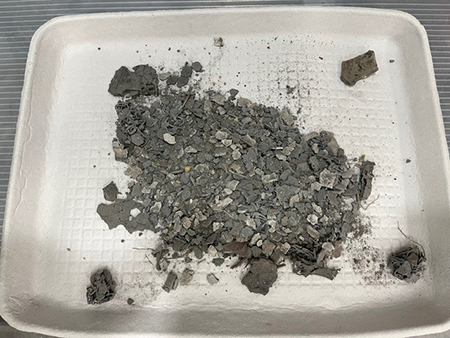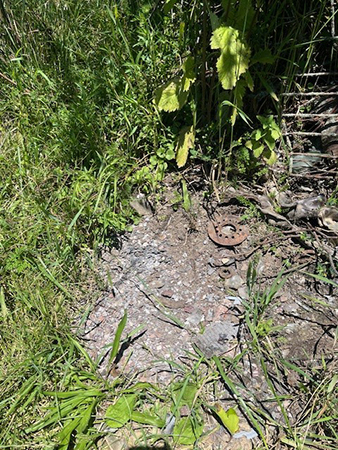Growing Beef Newsletter
May 2025, Volume 15, Issue 11
Lead Awareness: Clean out the junk and check the environment
Scott Radke, DVM, MS, DABVT Clinical Associate Professor
With spring now in full swing and cattle being turned out to pastures and lots of various types, producers should be aware of a lurking danger to cattle. Unfortunately, lead poisoning is an all too common occurrence in cattle during this time of year. Clinical signs of lead poisoning include ataxia, incoordination, tremoring, bruxism (grinding of teeth), depression, and blindness. Animals may be observed wandering aimlessly, standing listless, be recumbent, or seizing / convulsing, or may be found dead. Lesions at necropsy are few and usually nonspecific. However, close inspection of the gastrointestinal tract may reveal metallic material or plastic material suggestive of potential poisoning.

Figure 1. Lead battery fragments.
Prior to turnout onto pasture, a thorough walkthrough of the environment should be considered to identify potential sources of lead. Automobile batteries, especially those in junk piles or forgotten over the winter along fence lines, are the primary source of lead poisoning in cattle following turnout. When evaluating a premise for batteries, producers and practitioners should be aware that the form of the battery may not take on the standard “Black Box” form and shape. If a battery is crushed or incinerated in a junk pile, the plastic casing is destroyed, and the lead plates may appear like a burnt log with ashes (Figures 1 & 2). Wire grids supporting the lead plates are a giveaway that the material is a battery. A gray intact lead plate can be observed at about the four o’clock position in the pile. The battery displayed in Figures 1 and 2 was from a situation where calves had access to a small burn pile. However, due to the appearance of a burnt log, the battery was not initially recognized.

Figure 2. Burn pile.
Although batteries are the most common source of lead poisoning, other sources include lead-based paint, old building materials, engine oil, leaded gasoline, and old lead-arsenate pesticides. Care should be taken regarding cleanup following paint removal from old barns or outbuildings, especially if the paint is scraped or pressure-washed off into a bunk. A historical evaluation of sites where cattle are housed should be considered if cattle develop unexplained neurological signs, lead is detected, and no obvious sources are observed. Such sites could potentially overlay pits in which old buildings or junk may have been disposed of years, even decades before. Through wear and tear over the years, such materials may surface, exposing cattle to lead. Mortar used in older foundations may contain lead. Cows exposed to lead may serve as an additional source to nursing calves as lead is passed in the milk.
In regions where flooding has resulted from heavy rainfall, batteries have been known to wash up and be deposited in pastures that have been otherwise considered clean and free of such materials. Evaluation of flooded areas should be considered prior to returning cattle to pasture to prevent exposure and poisoning.
When lead or a potential differential diagnosis is suspected, submission of 2 ml of whole blood in a purple top EDTA tube is adequate for evaluation at the Iowa State University Veterinary Diagnostic Laboratory. Approximately 50 g (golf ball size) of liver is sufficient for lead analysis. Due to the neurological effects of lead poisoning, submission of fresh and fixed brain should also be considered to rule out other potential infectious or toxicological agents. Producers and practitioners should be aware that the brain alone is not sufficient to rule out lead poisoning.
Evaluation of the environment for sources of lead prior to turnout of cattle is strongly recommended. Turnout of cattle onto grounds containing old automobiles, assorted junk, batteries, and pails of oil and other automobile fluids should be avoided. Removal of or preventative measures to isolate such items should be performed.
This monthly newsletter is free and provides timely information on topics that matter most to Iowa beef producers. You’re welcome to use information and articles from the newsletter - simply credit Iowa Beef Center.
